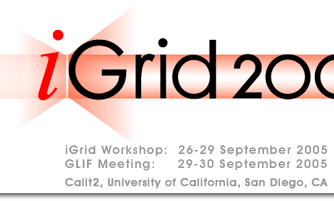News Releases
e-VLBI Measures Earth and Sky
By by Katie Yurkewicz
Science Grid This Week, October 19, 2005 - The technique of Very Long Baseline Interferometry has been used since the late 1960s by astronomers to make detailed images of distant radio-emitting objects in the universe, and by geoscientists to precisely measure the dynamics of the Earth. This well-established technique uses an array of independent antennas, scattered over the surface of the earth and synchronized with atomic clocks, to make simultaneous observations. With the use of global multi-gigabit optical networks, VLBI may be poised for a major upgrade.
“VLBI was originally developed by radio astronomers to make high-resolution measurements of quasars,” said Alan Whitney from the Massachusetts Institute of Technology’s Haystack Observatory. “In some VLBI observations, scientists can make high-resolution images of a distant radio source equivalent to discerning the dimples on a golf ball 3,000 miles away. The distances between the antennas can also be measured to an accuracy of a few millimeters anywhere on the surface of the Earth. This allows geophysicists and geologists to make direct measurements of the motion of the tectonic plates, as well as extremely accurate measurements of the motion of the Earth in space.”
Traditionally, VLBI data from up to 20 antennas are simultaneously recorded to magnetic tapes or disks and physically shipped to a central location, where a specialized processor called a correlator searches for common signals in the data. High-speed networks directly linking the antennas with the correlator would allow scientists to view the correlated signals very soon after they are recorded and adjust their observations accordingly. A networked e-VLBI system would also have the potential to move data at much higher rates, dramatically increasing the technique’s sensitivity.
To read the entire article, see: www.interactions.org/sgtw/2005/1019/evlbi_igrid_more.html


